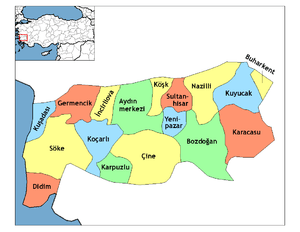Söke
| Söke | |
|---|---|
 Söke | |
| Coordinates: 37°45′3″N 27°24′37″E / 37.75083°N 27.41028°ECoordinates: 37°45′3″N 27°24′37″E / 37.75083°N 27.41028°E | |
| Country | Turkey |
| Province | Aydın |
| District | Söke |
| Government | |
| • Mayor | Necdet Özekmekçi (CHP) |
| • Prefect | Mehmet Demirezer |
| Area[1] | |
| • District | 986.62 km2 (380.94 sq mi) |
| Population (2012)[2] | |
| • Urban | 70,522 |
| • District | 115,586 |
| • District density | 120/km2 (300/sq mi) |
| Post code | 09200 |
| Website | www.soke.bel.tr |
Söke is a town and a large district of Aydın Province in the Aegean region of western Turkey, 54 km (34 miles) south-west of the city of Aydın, near the Aegean coast. It had 68,020 population in 2010. It neighbours are Germencik from north-east, Koçarlı from east, Milas from south-east, Didim from south-west, Aegean Sea from west and Kuşadası from northwest.
Etymology
Modern Söke is identified with the ancient Greek city of Anaia (Greek: Ἄνναια, Ἄναια, Ἀναία) (also referred to as Anea, Anaea, Annaea or Annaia), which named after the Amazon Anaea (Greek: Ἀναία).[3] Later, it was also called Sokia (Greek: Σώκια). As of 1920, the British were calling it Sokia.[4] Anaia is also the name of a titular see (Anaea) of the Catholic and Orthodox Churches, and the seat of an actual diocese of the Ecumenical Patriarchate of Constantinople from 1833 to 1922.
Geography
The district lies between the Aegean coast and the edge of the fertile alluvial plain of the Büyük Menderes River. Lake Bafa is to the south of the district. The plain contains much rich agricultural land, one of Turkey's largest cotton growing areas and also important for wheat and flour. Other income comes from handicrafts, forestry and fishing. Söke is Turkey's only exporter of culinary snails.
The Aegean region is rich in history and natural beauty, complemented with Mediterranean climate. Söke is a large town right in the centre of the region, the market town at the heart of a wealthy agricultural district, with a dramatic backdrop of mountains. Furthermore, although eclipsed by the nearby centres of tourism on the coast, Kuşadası, Didim and Bodrum, Söke does catch passing trade from the many visitors to the area, including visitors to the nearby historical site of Priene. There are a number of amenities on the highway for tourists passing through from Izmir airport to the coast, these include restaurants, service stations, and outlet stores selling cut-price clothing. The local cuisine includes çöp şiş (a shish kebab of small pieces of lamb) and pide (a flat bread pizza).
Söke is a town of 62,000 people.
History
Settled since the centuries BC, the region was called Aneon (Greek: Ανέων) and was inhabited by Greeks. Stephanus of Byzantium, quoting Ephorus, mention that the tomb of the amazon Anaea was at the city.[5] During the Peloponnesian War some Samian exiles posted themselves there. In addition, Thucydides mention that there was a naval station, and it was near enough to annoy Samos.[6]
In 1426 it was captured by the Ottoman Turks as remaining capital of the Sanjak of Menteşe.
In 18 May 1919, Italian troops landed at Söke, the Allies were afraid that the Italian landing may provoke trouble with the Greek troops, who were near Smyrna. Although Italy and Greece were allies during WWI their relations were not good.[7] In 1920, large Turkish and Arab forces were fighting against the Italian forces.[8] In April 1922 Italian troops withdrawn and Greek troops entered the area.[9] After the defeat of the Greek army in the Greco-Turkish War (1919–1922), Greek troops was withdrawn and Turkish troops entered in September 1922. Greek inhabitants of the area evacuated to Greece together with the Greek army or was killed by the advancing Turkish troops.[10] The Turkish resistance in the area was led by one Cafer Efe, whose statue is in the town.
The city was settled with Turkish immigrants from Crete during the Population exchange between Greece and Turkey in the 1920s.
Economy
Söke has a history of mining lignite. During World War I, it was producing large amounts of lignite. The British described the quality as being "very poor." It was exported to Smyrna via train and used in factories.[4]
Places of interest
- Priene - ancient ruins, 15 km (9 mi) from Söke
See also
- Lake Bafa
- Nalbandim
References
- ↑ "Area of regions (including lakes), km²". Regional Statistics Database. Turkish Statistical Institute. 2002. Retrieved 2013-03-05.
- ↑ "Population of province/district centers and towns/villages by districts - 2012". Address Based Population Registration System (ABPRS) Database. Turkish Statistical Institute. Retrieved 2013-02-27.
- ↑ http://www.perseus.tufts.edu/hopper/searchresults?page=2&q=Anaea
- 1 2 Prothero, G.W. (1920). Anatolia. London: H.M. Stationery Office. p. 101.
- ↑ Mary Bennett, Florence (December 2007). Religious Cults Associated With the Amazons. Forgotten Books. ISBN 978-1605063867.
- ↑ ANNAEA or ANAEA
- ↑ "Greeks Displeased". The Register (Adelaide). LXXXIV, (22, 640). South Australia. 2 June 1919. p. 5. Retrieved 5 July 2018 – via National Library of Australia.
- ↑ "Nine Wars On: Vast Sums for Armament". The World's News (989). New South Wales, Australia. 27 November 1920. p. 12. Retrieved 5 July 2018 – via National Library of Australia.
- ↑ "SOKIA OCCUPIED". The Sun (3581). New South Wales, Australia. 24 April 1922. p. 8 (FINAL EXTRA). Retrieved 5 July 2018 – via National Library of Australia.
- ↑ Kiminas, Demetrius (March 2009). The Ecumenical Patriarchate: A History of Its Metropolitans with Annotated Hierarch Catalogs. Wildside Press. p. 83. ISBN 978-1434458766.
External links
| Wikimedia Commons has media related to Söke. |
